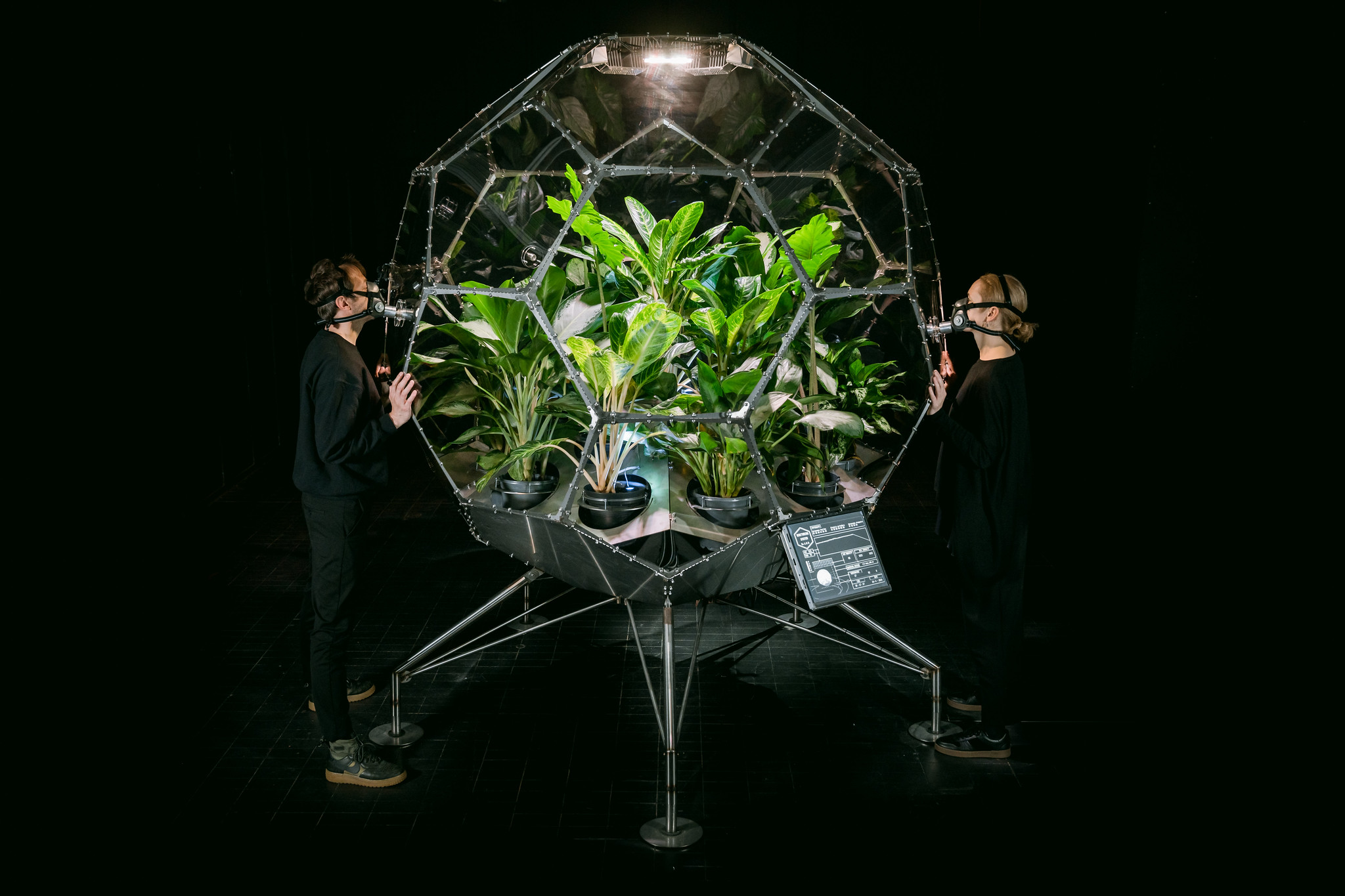The new exhibition at the Ars Electronica Center, “Connected Earth”, thematizes how the smallest creatures and powerful tides interact, what changes in biodiversity mean for man-made infrastructures, and what makes the Earth so habitable for millions of species, especially in their interaction.
Scientific methods and measuring techniques make planet Earth and its biodiversity tangible, archivable and explainable for people. It is the numbers, facts and studies that allow us to grasp interrelationships on the planet and to talk about them rationally. Despite clear research, it is easy to lose sight of the fact that human life in all its forms, colors and developments is integrated into the cycle of nature – and ultimately depends on the empathetic interaction of all actors and elements.
Take responsibility
Historically, the idea of a dualism of nature and culture has dominated social debates: untouched nature on the one hand, human culture and civilization on the other. Today, in the age of ecological crises, this juxtaposition is obsolete. The feminist-ecological philosopher Donna Haraway turns away from the concept of the Anthropocene and develops the idea of life in the “Chthulucene”, in which the close connection between species is the basic condition of all life. French sociologist Bruno Latour writes about the “Facing Gaia”, and James Bridle radically questions the notion of only one form of intelligence (namely the human one). The trend is clear: we all bear responsibility for each other.
The “networks” and (positive) dependencies between plants, animals and humans, the connections between climate change and exploitative conditions and the “invisible” relationships between all forms of life are the starting point for the new exhibition “Connected Earth”, which is being realized in cooperation with the Austrian Climate and Energy Fund at the Ars Electronica Center.
Small impulses with a great effect.
Symbolically, the delicate balance of the Earth is subject to the domino effect: a small impulse is enough to change the whole picture. Whether it is approaches such as the mobility turnaround, climate engineering or the long-term switch to resource-efficient, sustainable energy sources – one measure immediately has consequences for all parts of the Earth network. Within the framework of “Connected Earth”, visitors ask themselves what sustainable and fair coexistence could look like and what direct effects their own actions can have.
Hands-on exhibits, vivid models, touchscreens, apps and online tools invite you to get involved, while art installations offer a clear view of the close links between man-made infrastructures, flora and fauna – and illustrate the urgency of the need for action in the face of serious climate change.
Recognizing connections: the flora and us
Without photosynthesis by plants, there would be no human life on planet Earth. This is a simplification, but it is true that plant organisms are the most important natural sources of oxygen that give us the proverbial air we breathe. All organisms on Earth are part of a delicate system. The survival of the species is only ensured if each part plays its part.

Dorotea Dolinšek addresses the fragility of the Earth’s atmosphere, the gaseous envelope that makes life on the planet possible in the first place. In the middle of Connected Earth, the “Exo Auxiliary Respiratory Unit” (Ex.A.R.U.) brings a futuristic greenhouse into focus. If you take a look inside the glass structure, you will see a bed of broad-leaved, green tropical plants (Aglaonema and Alocasia). Encapsulated from the human world, a small habitat is created that is designed for maximum oxygen production. In order for photosynthesis and thus long-term life to succeed, carbon dioxide is needed in addition to light and water. This is where the visitors come into play: they enter the ‘breathing unit’ by connecting to the installation via an oxygen mask, breathing in air with the gentle sound of earth and plants and emitting carbon dioxide.
„The strongest element of the installation is the air. While the plants are crucial to the system, the project fundamentally explores an invisible yet indispensable substrate in which all living organisms are immersed in. It’s not just about the act of inhalation but about confronting the fragility of the thin atmospheric veil that sustains all life on Earth.”
– Dorotea Dolinšek
The installation is designed to make the “intangible tangible,” explains the artist. A person breathes in and out up to 32,000 times a day. This unconscious and self-evident process becomes a conscious and sensual experience with Ex.A.R.U., illustrating the interdependence of “humans, non-humans and the biosphere” on a shared planet, explains Dorotea Dolinšek.
„When participants put on the mask, there’s a crucial moment of asphyxia – a disruption in the natural rhythm of breathing. This suspension emphasizes the awareness of the fragility and immediacy of life’s dependence on air, and after all life’s interdependance.”
– Dorotea Dolinšek
In earlier works, Dorotea Dolinšek deliberately explored the potential for life in outer space and artistically addressed the question of how to make alien planets habitable for humans. One example is the TerraPort project, which was presented at the Ars Electronica Festival in 2022. Space seems to best illustrate the radical interdependence of all living systems, because to make life possible on other planets, the conditions on Earth must be recreated. “Astronauts must recycle water, cultivate plants, and produce air to live. This intimate dependency mirrors the increasing fragility of Earth’s ecosystems under ecological stress,” explains Dorotea Dolinšek, referring to current extreme climatic situations that threaten the Earth as a habitat. Forest fires, pollution and global warming create inhospitable conditions reminiscent of outer space: “The installation Ex.A.R.U. highlights the parallels between these conditions, urging us to see the Earth as a shared habitat that requires collective stewardship.”
Dorotea Dolinšek demonstrates how we depend on other functioning processes in our ecosystem and at the same time help to determine them. In Connected Earth, British artist and S+T+ARTS Prize winner Alexandra Daisy Ginsberg shows us how we can help to maintain and promote these collective processes in the long term. Human encroachment, such as excessive soil sealing, the creation of monocultures, and the use of pesticides in agriculture, have significantly altered the vegetation. Now it is time to think about how we – as a society and as individuals – can initiate a positive change. This requires courage first and foremost. It means putting aside our own human perspective on the world and approaching other points of view.

“Pollinator Pathmaker” by Alexandra Daisy Ginsberg asks: if pollinators designed gardens, what would humans see? It is an artwork for pollinators, planted and cared for by humans. Awarded the 2023 S+T+ARTS Grand Prize for Artistic Exploration, Pollinator Pathmaker is a one-of-a-kind experiment in interspecies design.
As numbers of pollinating insects around the world crash, Ginsberg worked with horticulturalists, pollinator experts, and a computer scientist to devise an algorithmic tool that designs planting for pollinators’ tastes, not human taste. The result is a growing series of algorithmically-generated living artworks, designed to maximise empathy towards pollinating insects. Every artwork generated is different, but each is computed to support the greatest diversity of pollinator species. By creating for other species, art becomes a platform for empathy and agency to care for them.
The first two Pollinator Pathmaker Editions opened in 2022; a 55m permanent installation at the Eden Project, Cornwall, and eleven meandering beds over 250m in Kensington Gardens, London, commissioned by the Serpentine. The third Edition, commissioned by LAS Art Foundation, opened in June 2023 in the forecourt of the Museum für Naturkunde, Berlin.
Pollinator Pathmaker is not just about large public artworks: you can also use the algorithmic tool for free to make your own living artwork at home. Simply follow the steps at pollinator.art to select your garden conditions and play with how the algorithm solves the problem of empathy. It then generates a planting scheme for you!

One Tree ID – How To Become A Tree For Another Tree, an artistic experiment by Agnes Meyer-Brandis, is an invitation to consciously perceive the relationships and communication pathways between different living beings and the environment. Placed in the foyer of the Ars Electronica Center, a Araucaria tree attracts everyone’s attention. The conifer tree and its characteristic scent become the starting point for a biochemical and biopoetic experiment.
The typical “forest smell” of a tree is also its messenger substance. The project uses air molecules – volatile organic compounds (VOCs) that are emitted by all plants. They serve to communicate with insects that guarantee pollination and thus the survival of the species. But how can humans gain insight into the dialogue? Agnes Meyer-Brandis extracted the gas emissions of the tree and, in collaboration with a perfumer, transformed the specific VOCs into four different scents: the odors of the treetop, tree trunk, roots, and the entire araucaria tree were bottled – and can be applied in the exhibition.
By capturing plant messengers in bottles, the artist speculates on how humans might enter into a symbolic and sensual dialogue with the trees around them. This allows us to experience another form of communication that goes unnoticed in our everyday lives.
People rely on the system of language. Clear words, one might think, should also lead to clear consequences. But not everything that is said leads to action. Let us think of the climate crisis and the fact that the first World Climate Conference took place in Geneva as early as 1979 – science has been communicating clearly for a long time that there is an urgent need for action. Why do these messages not get through and lead to sufficient action?
Lack of climate action? A look into space and back
“What is slowing down climate protection?” and ‘Can climate protection be faster?’ are direct questions that the KONTEXT Institute for Climate Matters is asking in the new exhibition. They are integrated into the wooden room architecture and are aimed at all visitors. Those seeking answers can scan the accompanying QR code with their smartphone and virtually immerse themselves in the research work surrounding (failed) climate measures.

Beatie Wolfe takes a more stringent approach and shows who has an interest in obscuring climate data and spreading trivializations and misinformation. In Smoke and Mirrors, the artist contrasts advertising slogans of the oil industry – such as “Out to clean the air” by Amoco and “Net-Zero” by Shell – with the increasing concentration of methane in the atmosphere. On the one hand, scientific data that consistently show the unrelenting negative trend since 1970, and on the other, advertising campaigns that deliberately fuel skepticism.
Beatie Wolfe received this year’s Golden Nica in the New Animation Art category for Smoke and Mirrors at the Prix Ars Electronica. But this is not her first foray into the climate crisis. Early on in her career, the artist addressed the question of how to present scientific data on climate change in a way that everyone can understand. With From Green to Red, she has already achieved this in an impressive way. The animation, which has won multiple awards and was presented to an international audience of experts at the 2021 Nobel Prize Summit, visualizes an impressive 800,000 years of historical NASA data that shows how CO₂ levels on Earth change drastically over time. As of today, it will be displayed daily between 9 p.m. to midnight on the façade of the Ars Electronica Center.

Even before companies launch major campaigns using traditional media, as Beatie Wolfe demonstrates, interest groups are coming together on digital media platforms. Misinformation, oversimplifications or conspiracy theories surrounding the climate crisis are posted, liked, shared and discussed with other users. Communities are forming across national and international borders, with their informal “members” maintaining a close exchange. This is shown by the Geosocial AI research group at the Paris Lodron University in Salzburg with the current project DEGENET (short for Threats to democracy on the net). The team conducts data analysis and uncovers spatial and geographical patterns in social media, thus showing where hotspots for the spread of conspiracy theories are forming. The data processing is intended to reveal anti-democratic developments and their real-world effects, and to call on decision-makers to develop effective counter-strategies and protect democratic systems.
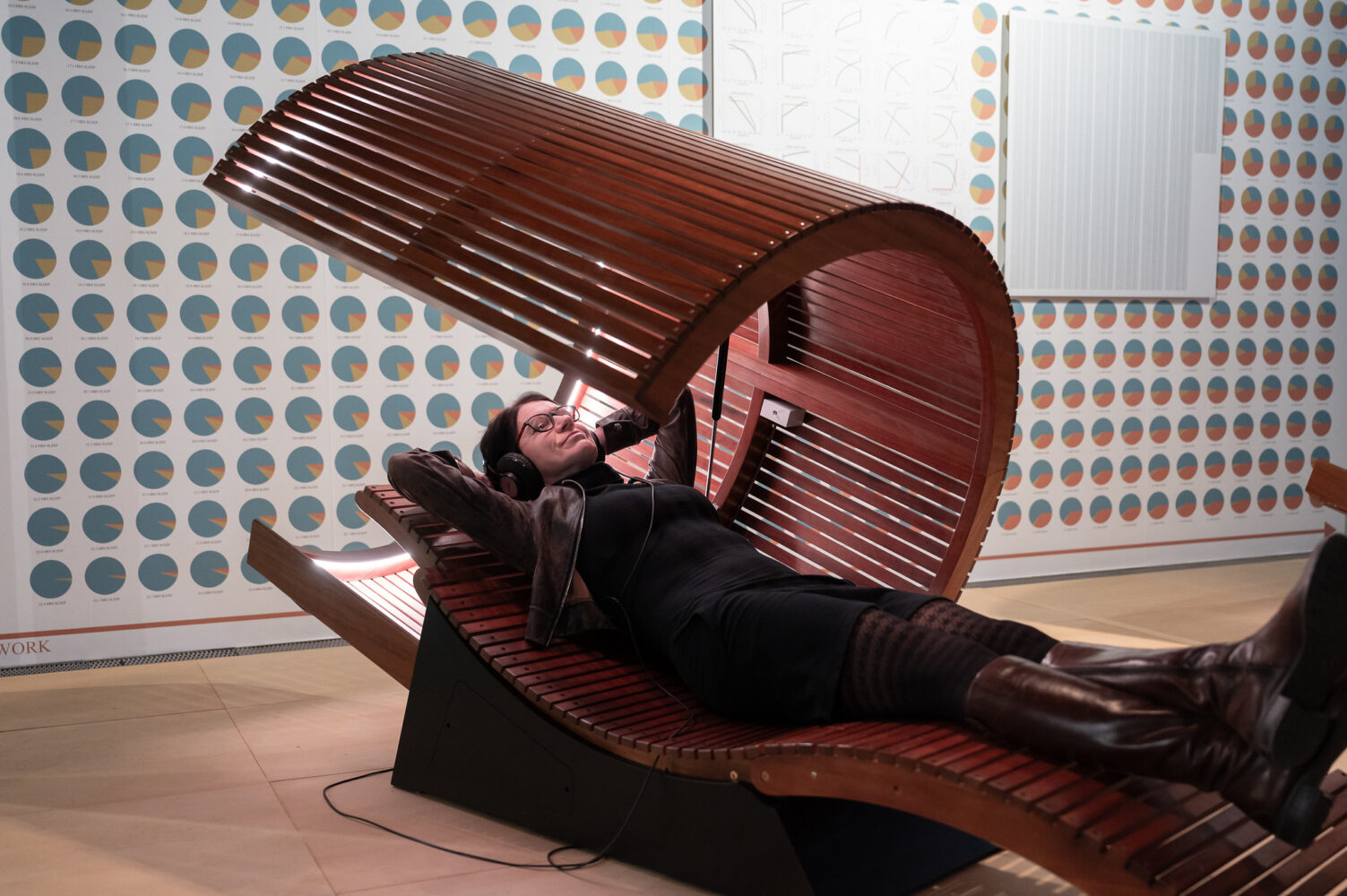
Recognizing connections: ecology, economy and well-being
Perfect Sleep by Tega Brain and Sam Lavigne examines the connection between sleep deprivation and climate change and criticizes the exploitative capitalist system, which – in both cases – disregards regeneration and natural limits. The installation draws on scientific surveys that reveal that most adults suffer from chronic sleep deprivation – there is talk of an “epidemic of unrest”. The reason for this is the enormous pressure of late capitalist structures on each individual. In addition, there is excessive internet and smartphone use:
“Every waking minute of our attention is now seen as a resource from which value can be extracted. […] Perfect Sleep is a project in a larger body of work addressing what we call ‘expanded geoengineering’ and where we attempt to reframe geoengineering as being more of a social challenge than a technological one.”
– Tega Brain und Sam Lavigne
In the course of the two-part art project, sleep and dream worlds are elevated to counter-strategies. Put bluntly: those who sleep more and work less are not only doing something for their own health, but are also reducing CO₂ emissions.
„We got really excited by the idea of sleep being a powerful climate technology and so we built what is essentially an alarm clock app, but one that gradually expands your sleep time by one minute per day. Productivity hasn’t yet been decoupled from carbon emissions so reducing your productivity is an effective way of lowering your carbon footprint.”
– Tega Brain und Sam Lavigne
According to the Perfect Sleep app, your sleep will get longer and longer over three years before the predicted “perfect sleep” occurs. To help you comply with this, there are two specially made wooden deckchairs in the exhibition where you can take a seat. You can listen to spoken and musical dreamscapes – but not random bedtime stories:
„To aid in falling asleep and to seed dreaming about other ways of living, we decided to commission some of our favorite writers to write dream incubation texts that could be listened to when drifting off. We asked Simone Browne, Johanna Hedva, Holly Jean Buck and Sophie Lewis to envisage alternative worlds that would help our users dream of life outside of capitalism.”
– Tega Brain und Sam Lavigne
Perfect Sleep is concerned with degrowth – in other words, with the possibility of abandoning the pursuit of profit and the desire for constant growth. It is about new ways of defining productivity. The artists argue that only a rethink in the economic and personal sense can bring about change:
“We are trying to provoke an imagination for doing less. Everyone – including those non-humans in the ecosystems that sustain us – is exhausted. Working less is key in making the changes necessary to address climate change.”
– Tega Brain und Sam Lavigne
From the corporations’ point of view, working less seems to be an impossibility, the dream of profit too promising. Tega Brain and Sam Lavigne counter this with scientific surveys that clearly show that the model of a four-day week would be a real opportunity to reduce CO₂ emissions worldwide and significantly improve the quality of life for everyone.
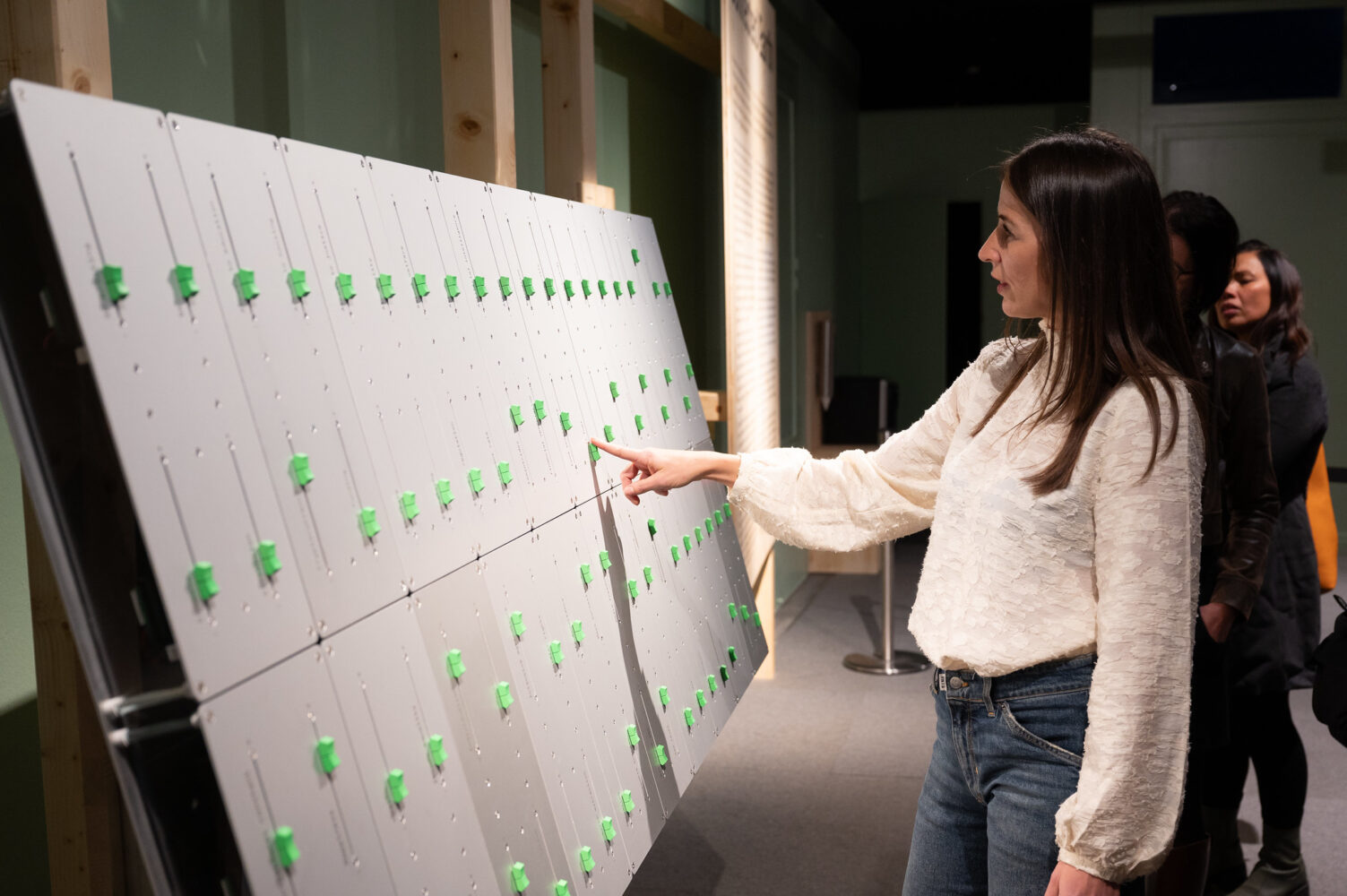
The provision of services, well-being and climate policy are intertwined here – social, political, economic and cultural developments can only be understood in relation to one another. This is also the approach taken by the Fragmentin collective with its G80 project, which was awarded an Honorary Mention by the Prix Ars Electronica in 2024 and is now being presented at the Ars Electronica Center.
G80 is an interactive installation that takes up Richard Buckminster Fuller’s World Game and transports his idea into the present. In the early 1960s, the US architect and futurist developed a simulation tool for dealing with world problems. Even then, he was of the opinion that there are comprehensive interrelations that require holistic solutions. The World Game was focused on the distribution of resources on a global scale. The alleged key to overcoming socio-political and ecological problems in the age of cybernetics: computers and mathematical models. G80 questions this number-oriented, technocratic hypothesis.
The artwork shows a console with 80 motorized sliders. The image is reminiscent of a control room from which central processes are controlled. Each slider is movable and corresponds to a variable. Some are directly inspired by Buckminster Fuller, while others, new variables, shed light on the big questions of our time: Nuclear Energy, Natural Disasters, Femicides, Income Equality, Health, Biodiversity, Automation, Air Quality, Animal Welfare, Fossil Fuel and Military Spending. Now it is the visitors’ turn to playfully stabilize the world by increasing (+) or decreasing (-) the values of the individual variables. It quickly becomes clear that all controllers correlate with each other. There is no final setting; order is repeatedly and thoroughly disrupted.
The exhibition Connected Earth invites visitors to reflect on the larger and smaller connections that make life on planet Earth possible and worth living. Artistic perspectives reveal what this interconnectedness is all about and how we can become aware of it. Practical projects from Linz and Austria demonstrate how committed citizens are already making a difference today, bringing environmental, economic, and social issues into a sustainable dialogue.
Finding alternatives: Hydrogen world Linz
Three high school students teamed up to develop a Minecraft mini-game in their project class at the Linz technical college. The game introduces children from elementary school age onwards to hydrogen as an environmentally friendly energy source. After almost a year of development, the students have now created the add-on – the “Hydrogen World Linz” can be explored and expanded using a controller. The goal is to establish hydrogen as the energy resource of the future.
“We have built a very individual map. Not a fictitious landscape with mountains and trees. With us, you navigate through a virtual version of Linz,” say Simon Ehrenhuber, Roberto Husli and Matthias Steininger. Mariendom, Hauptplatz, Ars Electronica Center, Donau, Bruckner Haus, Bosch, steelwork, harbour and LINZ AG are the cornerstones and provide orientation in the game world. Here, in the middle of Linz, players now have to produce hydrogen. The game, which has three educational levels, determines which conditions must be met, which materials are needed and which infrastructures have to be created. One task has to be solved per level – only those who complete them will see results.
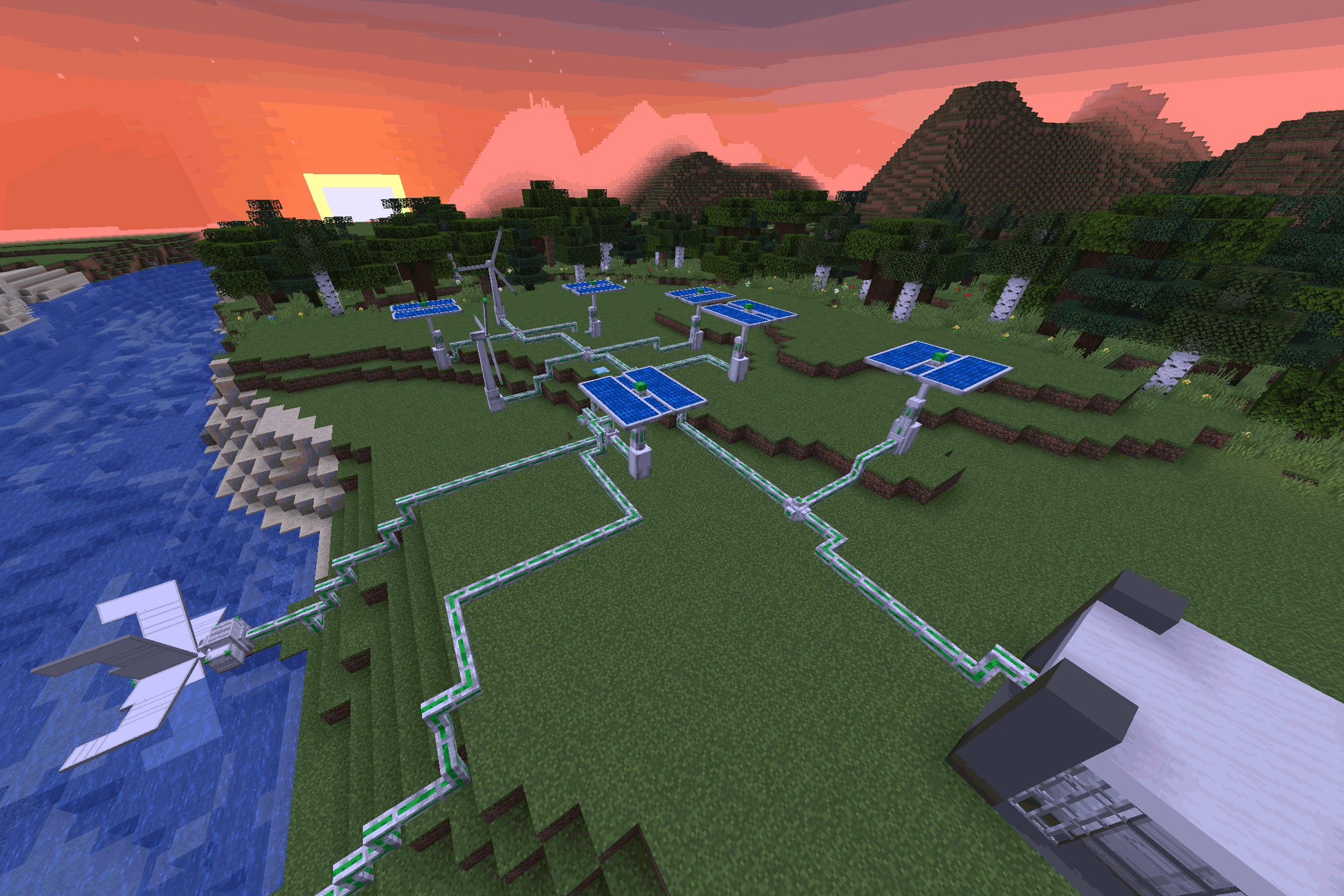
In level 1, the challenge is to produce green energy. “The players have to connect three electricity producers – a windmill, a water wheel and solar panels – to generate electricity,” the team explains. “This is done under simplified conditions and without real relations. We want to make the process accessible to children.” Once enough ‘electricity units per minute’ have been generated, the next step in Level 2 is to build an electrolyzer – a device that splits water into hydrogen and oxygen. “It takes three components to produce hydrogen: enough electricity, enough water and the electrolyzer,” the students summarize. Once the electrolyzer is ready for use, the chemical process is set in motion in Level 3 and hydrogen is produced. As soon as the energy is stored and ready for use, a camera pans across the virtual Linz, showing where it is used: in industry, for example in the form of a smoking chimney at the steelwork, in e-mobility or stored in an underground tank for later use in households.
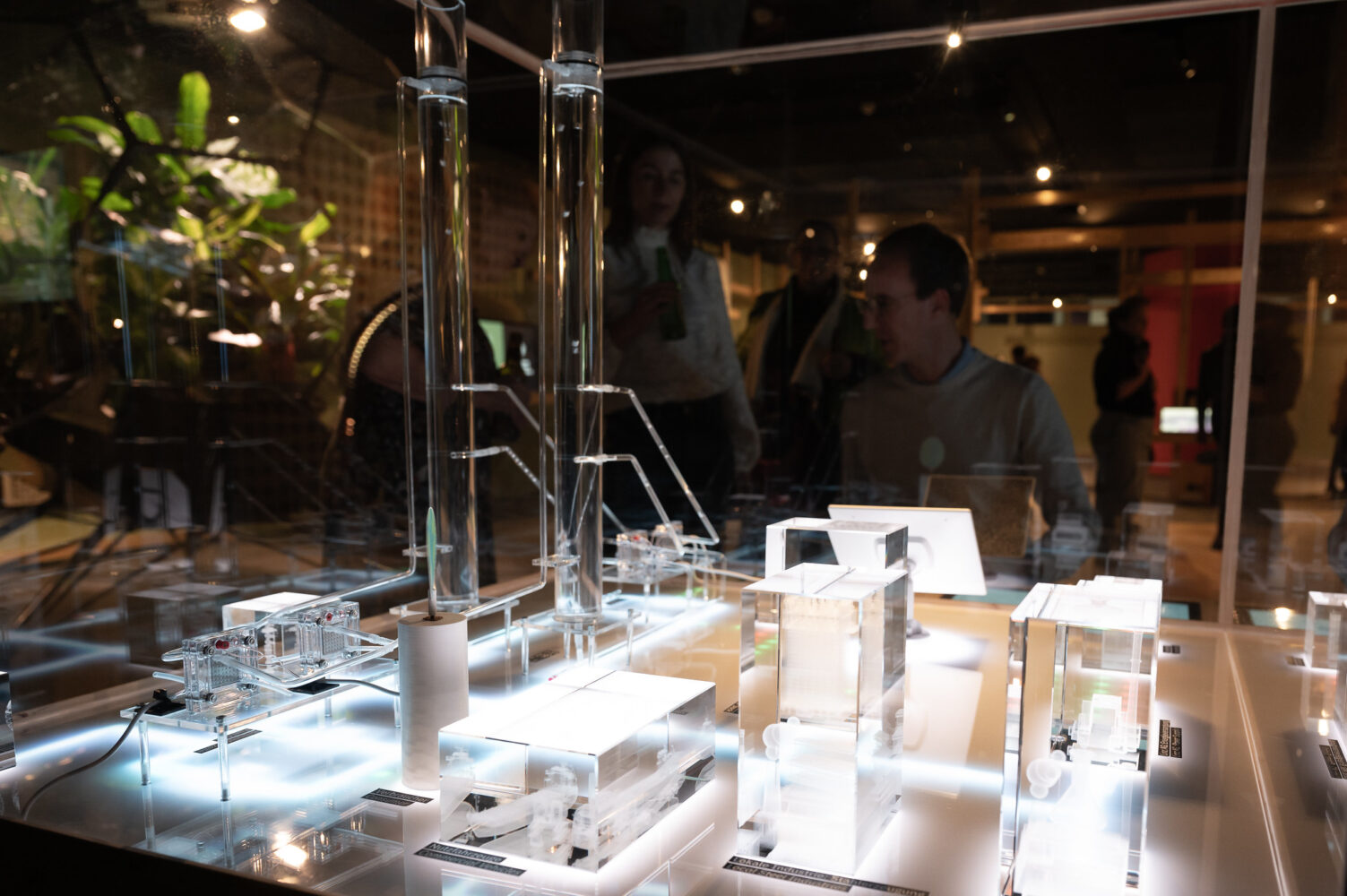
Those who want to explore the logical, rational aspect of hydrogen production away from gamification need only take a few steps further in the exhibition to try out the hydrogen value chain model by WIVA P&G, Ars Electronica, Robert Bosch AG, Linzer Technikum and LINZ AG with RAG Austria AG.
A model is often filigree and delicate, should serve as a visual aid but please be handled with kid gloves – not so with the interactive and playful hydrogen model. First, visitors crank the handle to generate energy by hand, which is then used to operate a real PEM (Proton Exchange Membrane) electrolysis process and to produce hydrogen. Once everything is done, a small globe begins to turn. The hydrogen value chain model illustrates the production, storage and use of green hydrogen – and demonstrates its role in future energy systems.
From reflection to realization: This is how it’s done differently
Models can reveal a great deal that is otherwise difficult to grasp. However, “Connected Earth” is not just about presenting artistic visions and explaining scientific approaches – it is primarily about practical action. At the Climate and Energy Fund’s best-practice station, a multi-touch terminal is used to discover which innovative model projects on the topics of the energy and mobility transition are currently running or have already been completed in Austria. Images and videos show what innovative companies and research institutions are working on and what goals are being pursued.
Until 2026 at the Ars Electronica Center
“Connected Earth” – the understanding that every living creature and every plant on our blue planet is part of an invisible network that literally keeps the cogs turning. At the Ars Electronica Center, this approach is the guiding principle that makes the joint exhibition with the Climate and Energy Fund so exciting with its diversity of positions and approaches. The aim is not to present individual approaches by way of example, but to show the opportunities that arise from engaging with different perspectives. One-off solutions have become useless; what is needed is collaboration, exchange and, above all, understanding for life forms other than our own. All this is shown in “Connected Earth” at the Ars Electronica Center from today until 2026.
You can find all information about the new “Connected Earth” exhibition at the Ars Electronica Center here.
